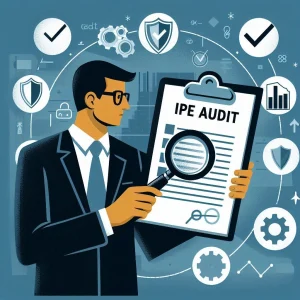Introduction to Internal Controls
Internal controls are essential mechanisms within an organization designed to safeguard assets, ensure the accuracy of financial reporting, and promote operational efficiency. They consist of a system of policies and procedures that help organizations manage risks and achieve their objectives. The five key components of an internal control system, as outlined by the Committee of Sponsoring Organizations of the Treadway Commission (COSO), include:
- Control Environment: This sets the tone for the organization, emphasizing integrity and ethical values.
- Risk Assessment: Identifying and analyzing risks that could hinder the achievement of objectives.
- Control Activities: The policies and procedures that help ensure management directives are carried out.
- Information and Communication: Ensuring relevant information is communicated effectively across the organization.
- Monitoring: Ongoing evaluations of the internal control system to ensure its effectiveness and make necessary adjustments.
The importance of internal controls in promoting organizational accountability cannot be overstated. They provide a framework that fosters transparency and responsibility among employees, ensuring that everyone understands their roles and obligations. By establishing clear accountability, organizations can reduce the risk of errors and fraud, improve the accuracy of financial reporting, and enhance overall operational efficiency [1][3][5].
Positive internal controls specifically refer to those practices that encourage ethical behavior and compliance with regulations, as opposed to negative controls, which are primarily focused on preventing undesirable outcomes. Positive controls create an environment where employees feel empowered to act responsibly and are motivated to adhere to established policies and procedures. This proactive approach not only mitigates risks but also cultivates a culture of accountability within the organization [12][14][15].
Understanding Accountability in Organizations
Accountability is a fundamental principle that underpins effective governance and operational success within organizations. For internal auditors and organizational leaders, understanding this concept is crucial for fostering a culture that promotes transparency, ethical behavior, and responsible decision-making.
Defining Accountability
Accountability in an organizational context refers to the obligation of individuals and teams to report on their activities, accept responsibility for their actions, and disclose the results in a transparent manner. It encompasses:
- Responsibility: Individuals must understand their roles and the expectations associated with them.
- Answerability: There should be mechanisms in place for individuals to explain their decisions and actions.
- Consequences: There must be clear repercussions for failing to meet responsibilities or for unethical behavior.
This definition emphasizes that accountability is not merely about compliance; it is about creating an environment where individuals feel empowered to take ownership of their actions and decisions, thereby contributing to the organization’s overall integrity and success.
The Relationship Between Accountability and Organizational Success
The link between accountability and organizational success is well-established. Organizations that prioritize accountability tend to experience:
- Enhanced Performance: When employees are held accountable, they are more likely to meet their objectives and contribute positively to the organization’s goals. This leads to improved overall performance and productivity.
- Increased Trust: A culture of accountability fosters trust among employees, management, and stakeholders. When individuals know that their actions are monitored and that they are responsible for their outcomes, they are more likely to act in the organization’s best interest.
- Risk Mitigation: Accountability helps in identifying and addressing potential risks before they escalate into significant issues. By ensuring that individuals are responsible for their actions, organizations can better manage compliance and operational risks.
The Role of Internal Controls in Fostering a Culture of Accountability
Internal controls are essential mechanisms that support accountability within organizations. They provide a structured framework that helps ensure that operations are conducted effectively and ethically. Key aspects of how internal controls promote accountability include:
- Establishing Clear Policies and Procedures: Internal controls define the processes and standards that employees must follow, which clarifies expectations and responsibilities. This clarity is vital for holding individuals accountable for their actions [2][4].
- Monitoring and Reporting: Effective internal controls include regular monitoring and reporting mechanisms that allow for the assessment of performance against established standards. This ongoing oversight ensures that individuals are aware of their responsibilities and the importance of adhering to them [1][9].
- Encouraging Ethical Behavior: A strong internal control environment emphasizes integrity and ethical values, which are critical for fostering a culture of accountability. When leadership demonstrates a commitment to ethical behavior, it sets the tone for the entire organization [6][11].
- Facilitating Transparency: Good documentation and record-keeping practices, as part of internal controls, provide a clear audit trail for all financial transactions. This transparency is crucial for accountability, as it allows stakeholders to understand how resources are being utilized and decisions are being made [15].
The Framework of Positive Internal Controls
The establishment of positive internal controls is crucial for promoting accountability within organizations. A well-structured internal control system not only safeguards assets but also enhances the integrity of financial reporting and operational efficiency. One of the most recognized frameworks guiding the development and implementation of these controls is the COSO (Committee of Sponsoring Organizations of the Treadway Commission) framework.
Introduction to the COSO Framework
The COSO framework, originally released in 1992 and updated in 2013, provides a comprehensive approach to internal control that is applicable across various industries. It outlines overarching principles that organizations can adopt to create effective internal control systems. The framework is designed to help organizations navigate the complexities of modern business environments, ensuring that internal controls are robust and adaptable to changing circumstances [1][3].
The Five Components of the COSO Framework
The COSO framework is built upon five interrelated components, each playing a vital role in fostering accountability within organizations:
- Control Environment:
- This component sets the tone for the organization, influencing the control consciousness of its people. It encompasses the integrity, ethical values, and competence of the entity’s personnel. A strong control environment promotes accountability by establishing a culture of transparency and ethical behavior, where employees understand their roles and responsibilities [5][12].
- Risk Assessment:
- Effective risk assessment involves identifying and analyzing relevant risks to the achievement of objectives. By understanding potential risks, organizations can implement appropriate controls to mitigate them. This proactive approach not only protects assets but also encourages accountability, as employees are made aware of the risks associated with their actions and decisions [5][8].
- Control Activities:
- Control activities are the policies and procedures that help ensure management directives are carried out. These activities can include approvals, authorizations, verifications, and reconciliations. By establishing clear control activities, organizations can hold individuals accountable for their actions, ensuring that processes are followed and objectives are met [5][14].
- Information and Communication:
- This component emphasizes the importance of timely and relevant information sharing within the organization. Effective communication ensures that all employees understand their roles in the internal control system and the importance of accountability. By fostering an environment where information flows freely, organizations can enhance decision-making and accountability at all levels [5][12].
- Monitoring Activities:
- Continuous monitoring of internal controls is essential for ensuring their effectiveness over time. This involves regular evaluations and assessments to identify any deficiencies in the control system. By actively monitoring controls, organizations can quickly address issues and reinforce accountability, as employees are aware that their actions are subject to review [5][8].
Implementing Positive Internal Controls
The establishment of positive internal controls is crucial for fostering accountability within organizations. These controls not only help in achieving operational efficiency but also ensure compliance with laws and regulations. Here are key steps and considerations for developing and implementing effective internal controls:
Key Steps for Developing and Implementing Effective Internal Controls
- Establish a Control Environment: The foundation of any internal control system is a robust control environment. This involves setting the tone at the top, where leadership demonstrates a commitment to integrity and ethical values. A strong control environment encourages employees to adhere to established policies and procedures, thereby promoting accountability [4].
- Conduct Risk Assessments: Identifying and assessing risks is essential for tailoring internal controls to the specific needs of the organization. This process involves engaging with risk and process subject matter experts to understand potential vulnerabilities and the impact they may have on achieving organizational objectives [5].
- Implement Control Activities: Control activities are the policies and procedures that help mitigate risks. These can include approvals, authorizations, verifications, and reconciliations. For instance, segregation of duties is a fundamental control that ensures no single individual has control over all aspects of a financial transaction, thereby reducing the risk of errors or fraud [3][12].
- Monitor and Review Controls: Continuous monitoring of internal controls is vital for ensuring their effectiveness. Regular audits and assessments can help identify areas for improvement and ensure that controls are functioning as intended. This ongoing evaluation supports a culture of accountability and transparency within the organization [11].
Importance of Leadership Support and Organizational Culture
The successful implementation of positive internal controls heavily relies on the support of leadership and the overall organizational culture. Leaders must actively promote the importance of internal controls and demonstrate their commitment through actions and resources. This includes:
- Encouraging Open Communication: Leaders should foster an environment where employees feel comfortable reporting concerns or suggesting improvements to internal controls. This openness can lead to enhanced accountability and a proactive approach to risk management [8].
- Training and Development: Providing training on internal controls and their significance can empower employees at all levels to take ownership of their roles in maintaining accountability. A well-informed workforce is more likely to adhere to established controls and recognize their importance [12].
Examples of Positive Internal Control Practices
- Segregation of Duties: As mentioned earlier, this practice is essential for preventing fraud and errors. By dividing responsibilities among different individuals, organizations can create a system of checks and balances that enhances accountability [3][14].
- Regular Audits: Conducting regular internal audits not only assesses the effectiveness of existing controls but also reinforces the importance of accountability. These audits can identify weaknesses and provide recommendations for improvement, ensuring that the organization remains compliant and efficient [10][15].
- Documentation of Policies and Procedures: Clearly documenting internal controls and procedures enhances understanding and consistency across the organization. This practice supports compliance efforts and enables continuous improvement, ultimately contributing to better governance and risk management [11].
The Impact of Positive Internal Controls on Accountability
Positive internal controls are essential mechanisms that organizations implement to ensure accountability, enhance operational efficiency, and promote a culture of integrity. By establishing a robust internal control framework, organizations can significantly improve their performance and mitigate risks. Here’s an analysis of how positive internal controls affect accountability and overall organizational performance.
Measurable Benefits of Positive Internal Controls
- Reduced Fraud: Organizations with strong internal controls experience fewer instances of fraud. By implementing measures such as regular audits and monitoring, companies can deter fraudulent activities and quickly identify any irregularities [1][12].
- Improved Compliance: Positive internal controls ensure that organizations adhere to laws, regulations, and internal policies. This compliance not only protects the organization from legal repercussions but also enhances its reputation among stakeholders [2][12].
- Enhanced Decision-Making: Accurate and timely information is crucial for effective decision-making. Positive internal controls facilitate the collection and analysis of reliable data, enabling leaders to make informed strategic choices that align with organizational goals [12][9].
Consequences of Lacking Positive Internal Controls
- Loss of Trust: When organizations fail to implement effective internal controls, they risk losing the trust of employees, customers, and stakeholders. A lack of accountability can lead to skepticism about the organization’s integrity and reliability [12][10].
- Reputational Damage: Incidents of fraud or non-compliance can severely damage an organization’s reputation. Negative publicity can result in decreased customer loyalty, loss of business opportunities, and challenges in attracting top talent [12][10].
Challenges in Maintaining Positive Internal Controls
Common Challenges
Maintaining effective internal controls is crucial for promoting accountability within organizations. However, several challenges can hinder the establishment and sustainability of these controls. Understanding these obstacles and implementing strategies to overcome them is essential for internal auditors and organizational leaders.
- Resistance to Change:
- Organizations often face pushback from employees when implementing new internal controls. This resistance can stem from a fear of the unknown or a belief that existing processes are sufficient. Change management strategies are necessary to address these concerns and foster a culture that embraces improvement [1].
- Lack of Resources:
- Many organizations struggle with limited financial and human resources, which can impede the development and maintenance of robust internal controls. This scarcity can lead to inadequate staffing for oversight roles or insufficient investment in necessary technology [2].
- Insufficient Training:
- A significant factor contributing to the failure of internal controls is the lack of employee knowledge and training. Without proper education on the importance and functionality of internal controls, employees may not adhere to established protocols, leading to potential lapses in accountability [3].
Strategies to Overcome Challenges
- Continuous Education:
- Implementing ongoing training programs can help employees understand the importance of internal controls and how they contribute to organizational accountability. Regular workshops and seminars can keep staff informed about best practices and regulatory changes [4].
- Stakeholder Engagement:
- Engaging stakeholders at all levels of the organization is vital for fostering a supportive environment for internal controls. By involving employees in the development and refinement of these controls, organizations can reduce resistance and enhance buy-in [5].
- Regular Assessment and Adaptation:
- Organizations must regularly review and adapt their internal controls to align with changing regulatory and risk landscapes. This proactive approach ensures that controls remain effective and relevant, thereby promoting accountability [6].
Conclusion: The Path Forward for Internal Auditors and Leaders
The significance of positive internal controls cannot be overstated. These controls serve as a foundational element in promoting accountability within organizations, ensuring that operations are conducted with integrity and transparency. Here are the key takeaways regarding the role of positive internal controls in fostering accountability:
- Framework for Governance: Positive internal controls create a structured environment that supports responsible governance. They help organizations safeguard assets, ensure the accuracy of financial reporting, and promote operational efficiency, which are all critical for maintaining accountability [2][9].
- Culture of Compliance: A strong commitment from leadership is essential in establishing a culture of compliance. When senior management prioritizes ethical behavior and accountability, it sets the tone for the entire organization, encouraging employees to adhere to established policies and procedures [5][8].
- Risk Mitigation: Effective internal controls are designed to identify and mitigate risks proactively. By implementing robust control activities, organizations can reduce the likelihood of errors and fraud, thereby enhancing the reliability of financial disclosures and overall operational integrity [11][12].
- Continuous Improvement: Monitoring and evaluating internal controls is vital for their effectiveness. Regular audits and assessments help organizations adapt to changing environments and improve their control systems, ensuring they remain relevant and effective in promoting accountability [1][6].
As internal auditors and organizational leaders, it is imperative to champion positive control practices. By advocating for the implementation and enhancement of internal controls, you can significantly contribute to a culture of accountability within your organization. This not only protects the organization’s assets but also fosters trust among stakeholders, including employees, customers, and investors.
For those looking to deepen their understanding and implementation of internal controls, consider exploring the following resources:
- COSO Framework: Familiarize yourself with the updated Internal Control – Integrated Framework by COSO, which provides comprehensive guidance on designing and implementing effective internal controls [1].
- Best Practices Guides: Seek out literature that outlines best practices for internal control systems, focusing on real-world applications and case studies that illustrate successful implementations [4][5].
- Professional Development: Engage in training and workshops that focus on internal auditing and control practices. These opportunities can enhance your skills and knowledge, equipping you to better advocate for positive internal controls within your organization [9][10].
By taking these steps, internal auditors and organizational leaders can pave the way for a more accountable and transparent organizational culture, ultimately leading to improved performance and stakeholder confidence.
Find out more about Shaun Stoltz https://www.shaunstoltz.com/about/
This post was written by an AI and reviewed/edited by a human.



